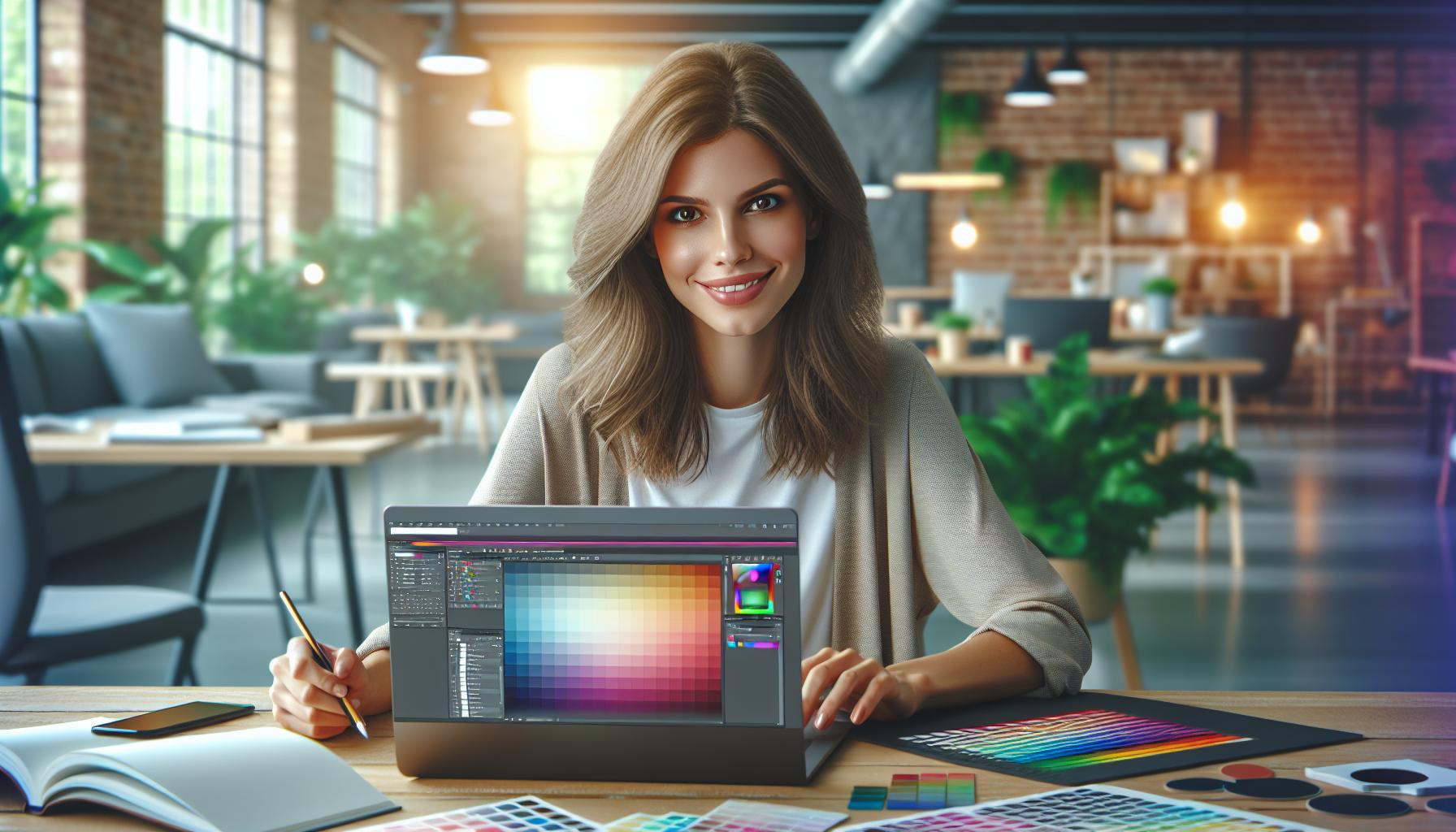Key Takeaways
- Photoshop’s Role in Web Design: Photoshop is a powerful tool for web designers, enabling the creation of stunning visuals that enhance user experience and engagement.
- Essential Tools for Beginners: Familiarize yourself with basic tools like selection tools, brushes, text tools, and layers, as they are fundamental for effective graphic design.
- Step-by-Step Learning: Engaging with structured step-by-step tutorials helps beginners grasp essential Photoshop techniques for creating layouts, headers, and using layers effectively.
- Design Principles: Understanding color theory and typography is crucial for creating attractive designs, ensuring readability, and conveying the brand’s message effectively.
- Best Practices: Implementing a grid system, maintaining consistent alignment, and utilizing whitespace can significantly improve the structure and clarity of web layouts.
- Continuous Improvement: Regular practice and exploration of Photoshop features can empower designers to address common challenges and produce professional-quality designs.
Diving into web design can feel overwhelming, especially for beginners. With tools like Photoshop at their fingertips, aspiring designers have the power to create stunning visuals that can elevate any website. Understanding how to harness this powerful software is essential for anyone looking to make their mark in the digital world.
Photoshop web design tutorials offer a gateway to mastering the basics and beyond. These tutorials break down complex concepts into manageable steps, guiding learners through the intricacies of graphic design. From creating eye-catching layouts to optimizing images for the web, beginners will find invaluable resources that empower them to unleash their creativity and build professional-looking websites.
Photoshop Web Design Tutorials For Beginners
Photoshop serves as a powerful tool in the web design process. It enables designers to create stunning visuals that enhance user experience and engagement.
What is Photoshop?
Photoshop is a graphic design software developed by Adobe Systems. It specializes in raster graphics editing. Designers utilize its extensive features for tasks such as image manipulation, photo editing, and creating complex graphics. It supports various file formats, making it versatile for different design projects.
Importance of Photoshop in Web Design
Photoshop plays a vital role in the web design workflow. It allows designers to create and refine website layouts, craft website elements, and prepare images for optimal web display.
- Visual Design: Photoshop facilitates the creation of unique visual elements like buttons, icons, and backgrounds that strengthen a site’s aesthetics.
- Prototyping: Designers can build prototypes and wireframes in Photoshop, helping clients visualize the final product.
- Image Optimization: Photoshop includes tools for optimizing images, ensuring they load quickly without losing quality. This aspect is crucial for web performance and can significantly impact user satisfaction.
- Collaboration: Many web designers work in teams, and Photoshop files can be easily shared, allowing for collaborative editing and feedback.
By mastering Photoshop, beginners can effectively address common design challenges and create professional-grade designs for the web.
Essential Tools and Features in Photoshop

Photoshop offers a variety of tools and features that serve as the foundation for effective web design. Understanding these elements allows beginners to navigate the software with confidence and precision.
Basic Tools for Beginners
- Selection Tools: Include the Marquee, Lasso, and Magic Wand. Selection tools help isolate specific parts of an image for modification.
- Brush Tool: Serves to paint and edit with customizable shapes and sizes. It creates unique designs and enhances artwork.
- Text Tool: Enables the addition of various text styles. Typography plays a crucial role in communicating brand messages.
- Shape Tools: Provide options to create geometric shapes. These elements contribute to layout design and visual balance.
- Color Picker: Allows for color selection and adjustment. Accurate color representation enhances the overall design quality.
- Layers: Facilitate the organization of design elements. Layers allow for easy adjustments and non-destructive editing.
- Adjustment Layers: Enable users to modify brightness, contrast, and color saturation. This feature helps maintain perfect aesthetics.
- Smart Objects: Support non-destructive scaling and editing. Smart Objects allow users to work on complex compositions without losing quality.
- Layer Styles: Offer effects like shadows, strokes, and glows. Layer styles enhance visual appeal and add depth to designs.
- Content-Aware Fill: Automatically fills selected areas with surrounding content. This tool streamlines image editing and background removal tasks.
Step-by-Step Tutorials

Step-by-step tutorials offer structured guidance for beginners to grasp essential Photoshop techniques in web design. These tutorials break down complex tasks into manageable actions, promoting effective learning.
Creating a Basic Web Layout
Creating a basic web layout involves planning and assembling structural elements using Photoshop.
- Open a new document: Set dimensions to 1920×1080 pixels for standard desktop screens.
- Use guides: Activate rulers and drag guides for alignment.
- Add a background: Choose a color or image that complements the design theme.
- Insert rectangles: Utilize Shape Tools to create placeholders for navigation, content sections, and footers.
- Adjust spacing: Maintain consistent margins between elements to ensure a balanced layout.
- Save your work: Regularly save as a PSD file to preserve layers and edits.
Designing a Website Header
Designing a website header contributes significantly to brand identity and user experience.
- Create a new rectangle: Use the Rectangle Tool to form the header shape.
- Select colors: Choose background colors that align with brand aesthetics.
- Incorporate the logo: Place the company logo in an appropriate position using the File > Place Embedded option.
- Add navigation links: Use the Text Tool to insert links, ensuring readability through font size and color contrast.
- Align elements: Utilize the alignment options to distribute elements evenly within the header.
- Group layers: Organize header components by grouping layers for efficient editing.
Using Layers and Effects
Using layers and effects enhances design flexibility and visual appeal in web layouts.
- Understand layers: Familiarize with the Layers panel; each element in the design occupies its own layer.
- Create new layers: For every new design element, create separate layers to maintain organizational clarity.
- Apply layer effects: Use effects like drop shadow or inner glow to add depth to elements.
- Utilize adjustment layers: Apply adjustment layers to fine-tune color and brightness without altering the original image.
- Mask layers: Employ layer masks to blend images seamlessly with backgrounds.
- Save frequently: Save designs as PSD files to retain all layers and modifications.
These tutorials empower beginners to build a foundational understanding of Photoshop while developing essential skills for effective web design.
Tips for Effective Web Design

Effective web design involves understanding both aesthetic principles and practical applications. Key considerations include color theory, typography, and layout best practices.
Color Theory and Typography
Color theory guides designers in selecting harmonious color schemes that evoke specific emotions and enhance user experience. Understanding color wheel relationships—such as complementary, analogous, and triadic schemes—helps create visually appealing designs. Utilizing contrast ensures readability and directs user attention to essential elements.
Typography plays a critical role in conveying brand identity and improving user engagement. Selecting appropriate fonts requires consideration of readability, style, and the target audience. Combining complementary typefaces—such as a sans-serif for headers and a serif for body text—creates a balanced and professional look. Maintaining consistency in font sizes, weights, and spacing contributes to a cohesive design.
Best Practices for Layouts
Effective layouts guide user navigation and emphasize essential content. Implementing a grid system organizes elements, providing structure and balance. Consistent alignment—whether left, center, or right—creates a clean look and improves readability.
Incorporating whitespace directs focus and prevents clutter. It’s critical to ensure responsive design, adapting layouts for various screen sizes. Establishing clear visual hierarchy emphasizes important information, using larger fonts and bolder colors to draw attention.
Ultimately, adopting these practices promotes an intuitive and engaging user experience, essential for successful web design.
Mastering Photoshop Opens up a World of Possibilities For Aspiring Web Designers
Mastering Photoshop opens up a world of possibilities for aspiring web designers. With the right tutorials and guidance beginners can transform their creative ideas into stunning visuals. The skills gained from these resources not only enhance design proficiency but also build confidence in navigating the complexities of web design.
By focusing on essential tools and principles beginners can create professional-grade designs that captivate users. Embracing the learning process and continually practicing will lead to significant improvements in their design capabilities. With dedication and the right approach mastering Photoshop will become a valuable asset in their web design journey.